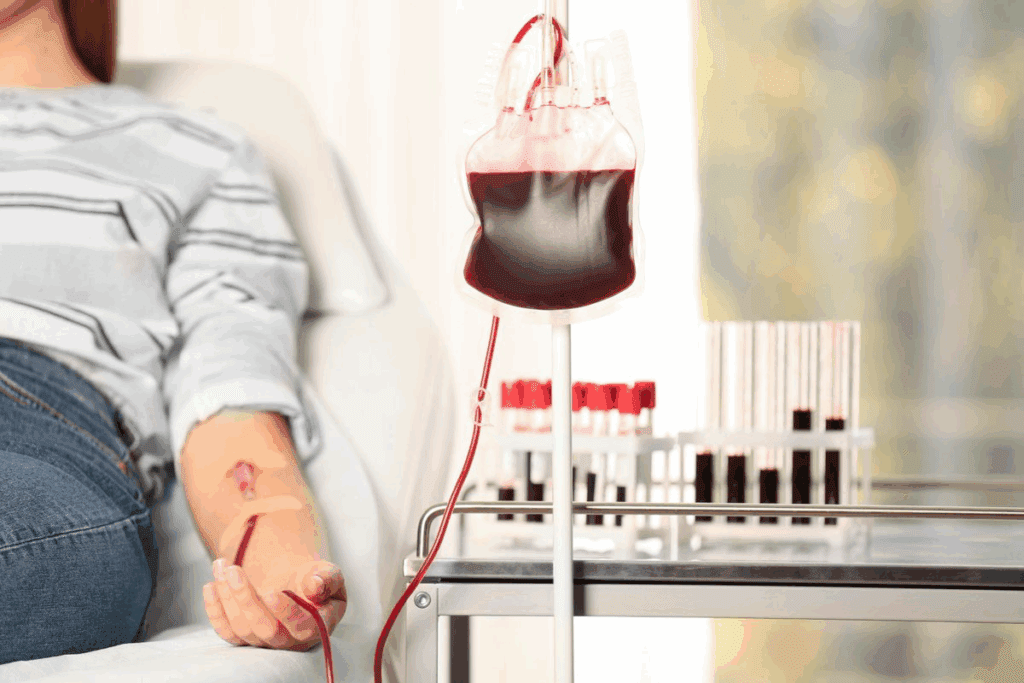Last Updated on November 25, 2025 by Ugurkan Demir

Blood thinners are key in stopping blood clots. They are vital for people with conditions like atrial fibrillation, deep vein thrombosis, and heart valve replacements.
At Liv Hospital, we believe in making informed healthcare decisions. We aim to help you understand the most common blood thinner medications. This way, you get the best care possible.
Anticoagulants and antiplatelet drugs are the main types of blood thinners. They prevent strokes, heart attacks, and pulmonary embolisms.

Blood thinners are important medicines that stop clots from forming in people at risk. They are given to those who might easily get harmful blood clots. These clots can cause serious problems like stroke, deep vein thrombosis (DVT), or pulmonary embolism.
It’s key for patients on blood thinners to know how they work. These medicines stop the body from making clots, which lowers the risk of clot-related problems. There are two main kinds: anticoagulants and antiplatelet agents. Each type works differently to prevent clots.
Blood thinners are vital in stopping harmful clots from forming. Anticoagulants directly stop the clotting process. They are often given to people with atrial fibrillation, DVT, or before certain surgeries. Common anticoagulants include warfarin, heparin, and DOACs like apixaban and rivaroxaban.
Antiplatelet agents prevent platelets from clumping together. Aspirin is a well-known antiplatelet drug, used in low doses to prevent heart attacks and strokes. Other antiplatelet drugs are clopidogrel and ticagrelor.
Blood thinners change the circulatory system by lowering clot risk. They help keep blood vessels healthy and ensure oxygen and nutrients reach tissues and organs. But, it’s important to weigh their benefits against the risk of bleeding.
Understanding how blood thinners work in the circulatory system is key. Anticoagulants like warfarin block vitamin K-dependent clotting factors. DOACs directly block specific clotting factors. Antiplatelet agents stop platelets from clumping.
Key benefits of blood thinners include:
Patients on blood thinners need to know their medication well. This includes side effects and the need for regular check-ups. Regular visits to healthcare providers are vital for adjusting doses and managing risks.

Managing cardiovascular health means knowing about blood thinners. These medications stop blood clots from forming. This can prevent heart attacks, strokes, and other heart problems. There are two main types: anticoagulants and antiplatelet agents.
Anticoagulants stop blood clots by blocking clotting factors or boosting anticoagulant proteins. Medications like warfarin, heparin, and DOACs (apixaban, rivaroxaban) fall into this category. They are for people at risk of DVT, pulmonary embolism, or stroke.
These drugs can be taken by mouth or injected. Warfarin is oral, while heparin is injected in hospitals. DOACs are easy to take by mouth and don’t need blood tests.
Antiplatelet agents stop platelets from clumping. Aspirin is a common one for heart attack or stroke risk. Other options include clopidogrel, prasugrel, and ticagrelor.
These drugs are great for people with heart disease or after stent placement. They keep arteries open, lowering heart event risks.
It’s key for patients to know the difference between anticoagulants and antiplatelet agents. Both prevent clots but in different ways. They’re used for different heart conditions.
Warfarin is a vitamin K antagonist that plays a key role in managing conditions that need anticoagulation. We will look at how warfarin works, its benefits and drawbacks, and the importance of monitoring and diet for patients on warfarin therapy.
Warfarin works by blocking the liver’s production of vitamin K-dependent clotting factors. These include factors II, VII, IX, and X, and proteins C and S. By blocking vitamin K, warfarin reduces the production of these clotting factors, preventing blood clots.
The effect of warfarin takes time because it doesn’t affect clotting factors already in the blood. It only affects new production. This means careful monitoring is needed to avoid too much clotting or bleeding.
Warfarin has been a key part of anticoagulant therapy for many years. It’s effective in preventing blood clots in patients with conditions like atrial fibrillation and deep vein thrombosis. Its benefits include:
But warfarin therapy also has some downsides:
Regular INR monitoring is key for patients on warfarin. The INR measures the blood’s clotting tendency. It should be between 2.0 and 3.0 for most conditions. Keeping the INR in this range is important to avoid too much clotting or bleeding.
What you eat is also important. Vitamin K in your diet can affect how well warfarin works. Patients should eat a consistent diet and avoid too much vitamin K, like in leafy green vegetables.
| Foods High in Vitamin K | Vitamin K Content (mcg per serving) |
| Kale, cooked | 540 |
| Spinach, cooked | 444 |
| Collard greens, cooked | 418 |
| Broccoli, cooked | 220 |
| Asparagus | 144 |
Understanding how warfarin works, its benefits and limitations, and following monitoring and dietary advice can help patients manage their condition. This minimizes risks from anticoagulant therapy.
Heparin is key in hospitals for stopping blood clots. It’s used for patients at risk, like those having surgery or with clotting conditions.
Unfractionated heparin (UFH) is given through an IV. It works fast to stop blood from clotting. This is great for urgent situations in hospitals.
Immediate Effect: Giving UFH through an IV lets doctors quickly change how much anticoagulant is in the blood. This is very important for patients with sudden blood clots.
Using heparin, like UFH, needs careful watching because it can cause bleeding. Activated partial thromboplastin time (aPTT) tests are used to check if the blood is clotting too much.
Knowing how heparin works in hospitals and how it’s given helps doctors take care of patients at risk of blood clots. This ensures the best results for these patients.
Low molecular weight heparins, like enoxaparin and dalteparin, offer a stable anticoagulant effect. They are key in preventing and treating blood clots.
Enoxaparin, known as Lovenox, is a popular low molecular weight heparin. It’s given by injection under the skin. It works well and doesn’t need constant monitoring.
It’s used to prevent blood clots in surgery patients and to treat heart attacks.
Key Features of Enoxaparin:
Dalteparin, or Fragmin, is another widely accepted low molecular weight heparin. It’s also given by injection under the skin. It’s used for preventing blood clots and managing heart attacks.
Dalteparin is a long-term treatment option for those at risk of blood clots.
Low molecular weight heparins, such as enoxaparin and dalteparin, have many benefits. They have a more stable effect, lower risk of blood clotting problems, and are easy to use without constant monitoring.
| Feature | Low Molecular Weight Heparins | Unfractionated Heparin |
| Administration Route | Subcutaneous | Intravenous or Subcutaneous |
| Monitoring Requirement | Generally not required | Requires aPTT monitoring |
| Risk of HIT | Lower | Higher |
Low molecular weight heparins are a top choice for treating blood clots. Their stable effect and lower risk of problems lead to better patient outcomes and quality of life.
Direct Oral Anticoagulants have changed how we prevent strokes and blood clots. They are easier to use than older medicines. This makes them a better choice for many people.
DOACs include apixaban, rivaroxaban, dabigatran, and edoxaban. They stop blood clots from forming in different ways. They are popular because they are simple to take and don’t need as much monitoring.
Apixaban stops Factor Xa, a key part of blood clotting. It’s taken twice a day. It’s good for preventing strokes in people with atrial fibrillation and has less bleeding risk.
Rivaroxaban is a Factor Xa inhibitor taken once a day. It helps prevent strokes in atrial fibrillation. It’s also used for deep vein thrombosis and pulmonary embolism.
Dabigatran blocks thrombin, a clotting enzyme. It’s taken twice a day. It’s as good as warfarin in preventing strokes, with less risk of bleeding in the brain.
Edoxaban is a once-daily Factor Xa inhibitor. It’s approved for stroke prevention and treating blood clots. Its dose is adjusted for kidney function and body weight.
In summary, DOACs are a modern choice over traditional anticoagulants. They require less monitoring and have fewer drug interactions. Each DOAC has its own benefits, and the right one depends on the patient’s needs and health situation.
Antiplatelet medications are key in stopping heart attacks and strokes. They work by stopping platelets from sticking together. We’ll look at the different types, how they work, and when they’re used.
Aspirin is a top choice for preventing heart problems. It stops platelets from clumping together by blocking a certain enzyme. Aspirin’s effect on platelets is well-known, making it a mainstay in heart health.
Clopidogrel is another common drug for heart health. It blocks a specific receptor on platelets, stopping them from sticking together. It works well with aspirin, and the two are often used together.
Prasugrel and ticagrelor are newer choices for heart patients. Prasugrel blocks the same receptor as clopidogrel but works faster and stronger. Ticagrelor targets the same receptor but in a different way. These drugs have been shown to reduce heart problems in certain patients.
Dipyridamole is another drug that stops platelets from sticking. It works by increasing a chemical that stops platelets from clumping. It’s often paired with aspirin for better protection. Combining drugs like aspirin and dipyridamole targets platelets from different angles, helping prevent blood clots.
In summary, antiplatelet medications are vital for heart health. They offer various options to prevent blood clots. By knowing how each drug works, doctors can choose the best treatment for each patient, improving health and reducing risks.
Choosing the right blood thinner is not simple. It needs a careful medical check. The best choice depends on many factors, like the patient’s health and the condition being treated.
Many things affect which blood thinner is best. These include the patient’s health history, kidney function, and drug interactions. For example, someone with kidney disease might need a blood thinner that doesn’t rely on the kidneys to clear it.
Age, weight, and lifestyle also matter. A person at high risk of bleeding might get a blood thinner that’s easier to predict.
The medical condition being treated is key. For atrial fibrillation, the choice depends on the risk of stroke versus bleeding. In deep vein thrombosis, the severity of the clot and how well the patient responds to treatment are important.
For those with mechanical heart valves, the options are limited. Warfarin is often chosen because it’s effective in preventing valve problems.
How often the blood thinner needs to be checked is important. Some, like warfarin, need regular tests to work right and avoid bleeding.
Direct oral anticoagulants (DOACs) usually don’t need regular checks. This makes them easier for some patients. But, it’s important to weigh the benefits against the risks of not monitoring as closely.
Cost and insurance also matter a lot. Different blood thinners cost different amounts, and insurance can affect what patients pay out of pocket.
It’s important to think about the total cost of the blood thinner. This includes the medicine itself, monitoring, and managing any problems that might arise.
Living with blood thinners means knowing your medication well. You must follow your doctor’s instructions and watch out for side effects. There are different types of blood thinners, like warfarin and DOACs, and antiplatelet agents like aspirin.
It’s key to learn about your medication. Knowing how to manage your treatment can help avoid problems. For example, regular INR checks for warfarin users are important. Also, following dietary advice can help keep you safe.
Being careful is also important. Avoid injuries and know how to handle bleeding risks. This way, you can stay safe while taking blood thinners.
By staying informed and working with your doctor, you can manage your condition well. This approach helps reduce risks from blood thinner therapy. We suggest patients to create a plan with their healthcare providers for safe living with blood thinners.
Blood thinners help prevent blood clots. They are given to people at risk of heart attacks, strokes, or deep vein thrombosis.
There are anticoagulants and antiplatelets. Anticoagulants, like warfarin, stop clotting factors in the liver. Antiplatelets, such as aspirin, stop platelets from clumping.
Your healthcare provider will choose based on your condition and other health factors. They will pick the best one for you.
Common ones include warfarin, apixaban, rivaroxaban, dabigatran, edoxaban, aspirin, and clopidogrel.
Monitoring depends on the blood thinner. Warfarin patients need regular INR checks. DOACs usually don’t need regular checks. Your doctor will tell you when to get checked.
Yes, some blood thinners, like warfarin, need special diets. Foods high in vitamin K can affect warfarin. Your doctor or dietitian can help with this.
Always tell your doctor about all medications and supplements. They can check for any bad interactions and make changes if needed.
Side effects include bleeding and bruising. The specific side effects depend on the blood thinner. Your doctor will talk about these and how to handle them.
The time you take blood thinners depends on your condition and health. Some people take them for a short time, while others for longer.
If you miss a dose, take it as soon as you remember. Skip it if it’s almost time for the next one. Never take two doses at once. Ask your doctor for advice.
Subscribe to our e-newsletter to stay informed about the latest innovations in the world of health and exclusive offers!